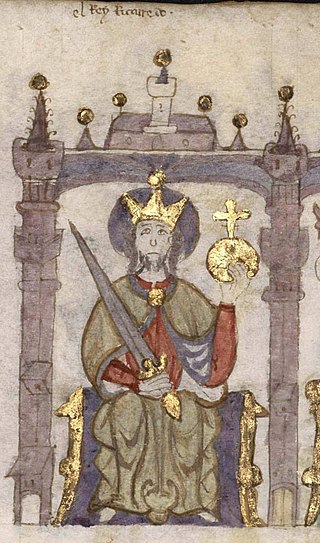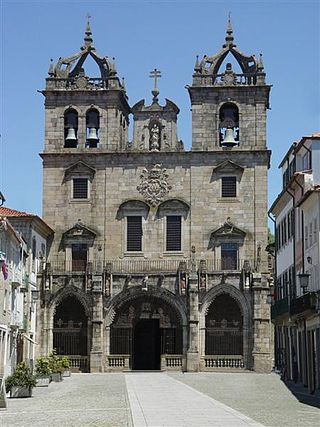
Reccared I was Visigothic King of Hispania and Septimania. His reign marked a climactic shift in history, with the king's renunciation of Arianism in favour of Roman Christianity in 587.

Saint Hermenegild or Ermengild, was the son of King Liuvigild of the Visigothic Kingdom in the Iberian Peninsula and southern France. He fell out with his father in 579, then revolted the following year. During his rebellion, he converted from Arianism to Chalcedonian Christianity. Hermenegild was defeated in 584 and exiled. His death was later celebrated as a martyrdom due to the influence of Pope Gregory I's Dialogues, in which he portrayed Hermenegild as a "Catholic martyr rebelling against the tyranny of an Arian father."

The Third Council of Toledo (589) marks the entry of Visigothic Spain into the Catholic Church, and is known for codifying the filioque clause into Western Christianity. The council also enacted restrictions on Jews, and the conversion of the country to Catholic Christianity led to repeated conflict with the Jews.
John of Biclaro, Biclar, or Biclarum, also Iohannes Biclarensis, was a Visigoth chronicler. He was born in Lusitania, in the city of Scallabis. He was also bishop of Girona.

Witteric was the Visigoth King of Hispania, Septimania and Galicia. He ruled from 603 to 610.

Liuvigild, Leuvigild, Leovigild, or Leovigildo, was a Visigothic King of Hispania and Septimania from 568 to 586. Known for his Codex Revisus or Code of Leovigild, a law allowing equal rights between the Visigothic and Hispano-Roman population, his kingdom covered modern Portugal and most of modern Spain down to Toledo. Liuvigild ranks among the greatest Visigothic kings of the Arian period.

The Kingdom of the Suebi, also called the Kingdom of Galicia or Suebi Kingdom of Galicia, was a Germanic post-Roman kingdom that was one of the first to separate from the Roman Empire. Based in the former Roman provinces of Gallaecia and northern Lusitania, the de facto kingdom was established by the Suebi about 409, and during the 6th century it became a formally declared kingdom identifying with Gallaecia. It maintained its independence until 585, when it was annexed by the Visigoths, and was turned into the sixth province of the Visigothic Kingdom in Hispania.

Theodemir or Theodemar was one of the last Suevic kings of Galicia and one of the first Chalcedonian Christians to hold the title. He succeeded Ariamir sometime between the end of May 561 and the year 566 and ruled until his death.

The Archdiocese of Braga is a Latin Church ecclesiastical territory or archdiocese of the Catholic Church in Portugal. It is known for its use of the Rite of Braga, a use of the liturgy distinct from the Roman Rite and other Latin liturgical rites.

The Diocese of Porto (Oporto) is a Latin Church diocese of the Catholic Church in Portugal. It is a suffragan of the archdiocese of Braga. Its see at Porto is in the Norte region, and the second largest city in Portugal.

Masona or Mausona was the Bishop of Mérida and metropolitan of the province of Lusitania from about 570 until his death. He is famous for exercising de facto rule of the city of Mérida during his tenure as bishop and for founding the first confirmed hospital in Spain.
Athaloc was the Visigothic Arian Archbishop of Narbonne at the time of the Third Council of Toledo in 589. He was the metropolitan of his province in parallel with the Catholic hierarchy.
Gonçalo (Gonçalves) Pereira (c.1280–1348) was a Portuguese prelate of the Catholic Church who served as the archbishop of Braga from 1326 until 1349.

The Archdiocese of Mérida–Badajoz is a Latin Church ecclesiastical territory of the Catholic Church in Spain, created in 1255. Until 1994, it was known as the Diocese of Badajoz.

The Diocese of Viseu is a Latin Church diocese of the Catholic church in Portugal. It is a suffragan of the archdiocese of Braga. Its see at Viseu is in the Centro Region. The current bishop is António Luciano dos Santos Costa.
The Primacy of the Spains is the primacy of the Iberian Peninsula, historically known as Hispania or in the plural as the Spains. The Archbishop of Braga, in Portugal, has claimed this primacy over the whole Iberian Peninsula since the middle ages, however today his primacy is only recognized in Portugal. The Archbishop of Toledo in Spain has claimed the Primacy of Spain, as the primate above all other episcopal sees in Spain. In addition, the Archbishop of Tarragona in Catalonia also makes use of the title. The Archbishops in Braga, Toledo and Tarragona, if raised to the rank of cardinal, are known as Cardinal-Primates.
The Catholic Church in Spain has a long history, starting in the 1st century. It is the largest religion in Spain, with 58.6% of Spaniards identifying as Catholic.
Becila was a Medieval Hispanic church clergyman Galician and an Arian bishop of Lugo in the late sixth century.
Ingunde, Ingund, Ingundis or Ingunda, was the eldest child of Sigebert I, king of Austrasia, and his wife Brunhilda, daughter of King Athanagild of the Visigoths. She married Hermenegild and became the first Catholic queen of the Visigoths.

D. João de Sousa was a Portuguese prelate, Bishop of Porto, Archbishop of Braga and Archbishop of Lisbon.












